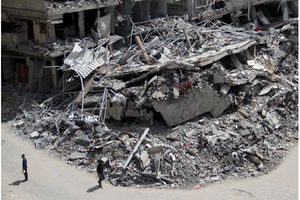Prime
Making sense of the kobs’ mass capture

Game rangers struggle to subdue the kobs. PHOTO | COURTESY
What you need to know:
- The Kabwoya wildlife reserve, which straddles 87 square kilometres, currently plays host to nearly 8,000 kobs. Such growing numbers are known to increase pressure on land. This is especially evident during the dry season when grazing on meadows cannot be assured.
Last month, Uganda Wildlife Authority (UWA) carried out its second translocation exercise of kobs to Kidepo Valley National Park in Karamoja Sub-region.
The first such exercise that saw 110 kobs translocated from Murchison Falls National Park to Kidepo took place in 2017. This time around 200 kobs were translocated from Kabwoya Wildlife Reserve in Hoima to Kidepo.
After Mr John Makombo, the UWA’s director for conservation, flagged off the exercise mid last month, 30 kobs were captured on the first day.
The translocation or movement from one place to another is tailored to reinforce the animal population by enhancing breeding and ecosystem balance.
Ultimately, it improves tourism prospects. Little wonder, Dr Margaret Driciru—the acting chief warden of Murchison Falls conservation—couldn’t hide her excitement.
“We are very happy because we have been very successful and are taking the kobs to Kidepo to recover the populations that are dwindling,” she told this publication.
The Kabwoya wildlife reserve, which straddles 87 square kilometres, currently plays host to nearly 8,000 kobs. Such growing numbers are known to increase pressure on land. This is especially evident during the dry season when grazing on meadows cannot be assured.
Case for translocation
Mr Makombo revealed that besides widening the range land for the kobs in the event of any emergency in Murchison, the latest translocation is cognisant of the dynamics of oil production that do not rule out oil spills. It is also mindful of the fact that the lion population in Kidepo is under some kind of threat.
“Every time the lions try to hunt buffaloes, they are instead hunted because they are overpowered by the mighty horns of the buffaloes,” Mr Makombo said, adding, “So we need to save the population of lions in Kidepo by taking a species of animals that can multiply fast and also the lions can feed on.”
The kobs that were captured during last month’s translocation had to endure a 485km journey before being successfully released into Kidepo.
Capturing the swift herbivores was no mean feat. Unlike the method used for capturing big wildlife like elephants and giraffes, which requires darting, a mass capture usually comes in handy during a translocation of kobs. It is, however, not as easy as it sounds.
Rangers gathered at their range post at Kabwoya Wildlife Reserve as early as 8am. They then clambered into pick-up trucks that took them to the site where a boma carved out of canvas was erected to help capture the kobs.
At the site, young female and male kobs formed loose groups of varying size. These typically moved along watercourses and grazed in valley bottoms. As they helped themselves to anything from grass to reeds, Dr Patrick Atimnedi—UWA’s manager veterinary services—outlines the dos and don’ts during the mass capture.
Pre-mass capture rituals
The formation that was adopted on the day was one where the vehicles were spread out metres away from the boma. They then set off on closing in towards the start of the 360-metre length boma.
“These kobs are very sensitive and have a very strong sense of smell in case they smell urine, they may not come close,” one of the rangers, tells us as we waited for the kobs to enter into the trap that had been laid out.
Indeed, we were not allowed to use any body sprays before coming to witness the translocation. Since we all religiously followed the instructions—that also included keeping quiet before the mass capture—the kobs did come our way.
The pick-up trucks started moving, with the one on the extreme left setting off first at an almost walking pace. The others soon followed as they all closed in on the boma. The pace of the trucks picked up as they closed in. The first attempt would yield no capture. All kobs miraculously escaped.
Second bite at cherry
This forced the 40-strong team to retreat and re-strategise. During the second attempt, two vehicles moved to the extreme upper end close to the lake where the kobs had gone to quench their thirst. This led the herbivores towards the boma.
This was a cue for the other trucks to start closing in slowly. Each one covered the other, denying the kobs any space to escape.
At the behest of the commander, all the vehicles accelerated. The rangers who mounted the trucks made all kinds of noises as the trucks gave chase.
“This noise helps us confuse the kobs and gives them no time to think twice as they scamper for dear life,” a ranger told Saturday Monitor.
The second attempt was successful as a number of kobs were driven into the boma. This, though, was just the start of a gruelling task. With the kobs cornered, the rangers now needed to wrestle them down. When they succeeded at that, the vets would spring into action. Some took blood samples, others tagged the animals. Dr Driciru told us this was done to ascertain the health status of the animals being translocated, among others.
After, the screened kobs were pushed into a cart crouched down on a waiting truck. They were then translocated into Kidepo.


